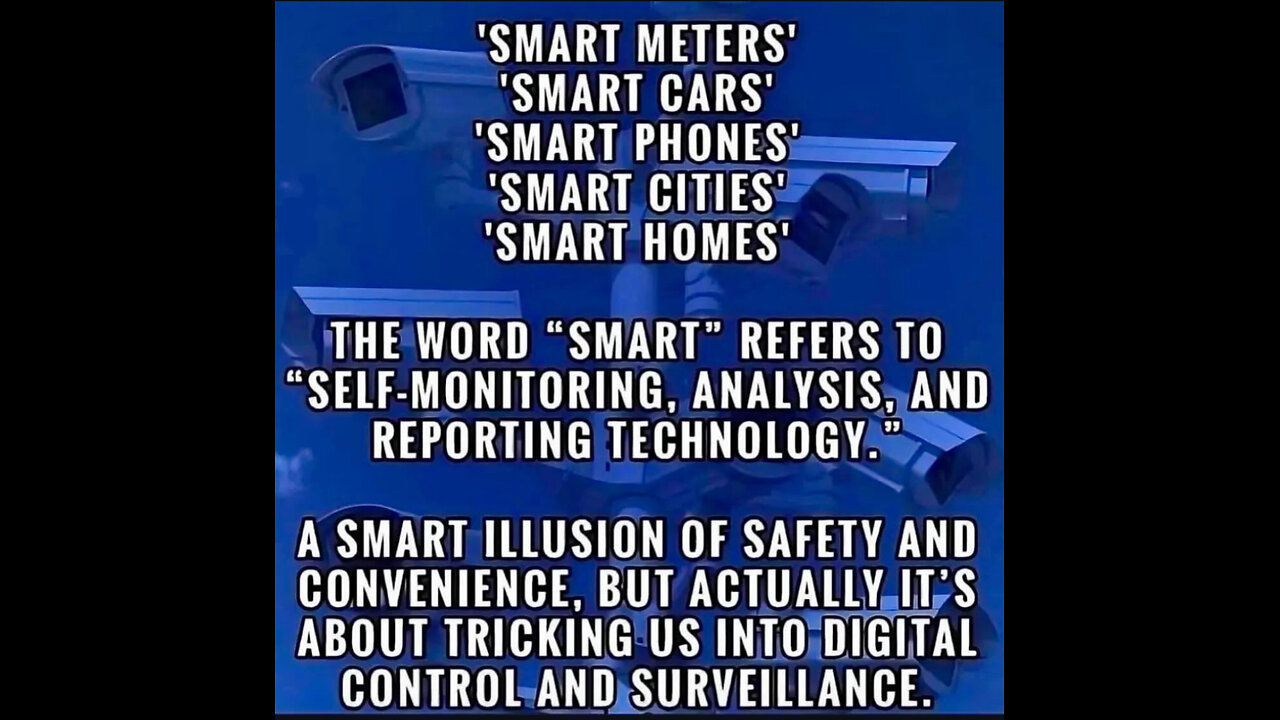Premium Only Content

The Veil of Proximity: Unmasking the Fifteen-Minute Smart City Agenda
Imagine a city where everything you need—work, groceries, healthcare, leisure—is just a 15-minute walk or bike ride away. It’s sold as a dream of convenience, sustainability, and community: less traffic, cleaner air, stronger neighborhoods. But what if this utopian vision is a Trojan horse, concealing a darker agenda of surveillance, control, and the erosion of personal freedom? Welcome to the hidden architecture of the fifteen-minute smart city.
I. The Inception: A Convenient Facade
The fifteen-minute city concept emerged in 2016 from urbanist Carlos Moreno, a French-Colombian thinker who envisioned urban life reorganized around proximity. It’s a compelling idea—reduce car dependency, curb emissions, and bring daily necessities closer to home. Cities like Paris and Edmonton, Alberta, have embraced it, with Edmonton aiming to house 600,000 new residents through infill development and transit-focused travel by 2050. On the surface, it’s about livability. But dig deeper, and the picture shifts.
The World Economic Forum (WEF), a lightning rod for conspiracy theorists, has championed this model as part of its “Great Reset” initiative—a post-COVID plan to “build back better.” The WEF’s involvement raises red flags. Why would a globalist organization, often accused of pushing top-down governance, care about neighborhood walkability? Perhaps because this isn’t just urban planning—it’s a blueprint for societal restructuring, cloaked in the language of sustainability.
• The Kernel of Truth: Smart cities, the technological backbone of this vision, rely on a dense network of sensors, cameras, 5G infrastructure, and AI analytics. Edmonton’s plan, for instance, emphasizes “smart land use” and data-driven governance. Officially, it’s about efficiency. Unofficially, it’s a system ripe for exploitation.
II. The Architecture of Control: Surveillance by Design
At the core of the fifteen-minute smart city is data—your data. Sensors embedded in streets, buildings, and public spaces track everything: how you move, what you buy, who you meet. In Edmonton, this tech is pitched as a way to optimize traffic and energy use. But it’s also a panopticon—a surveillance grid where no action goes unnoticed. This isn’t futuristic fiction; it’s an extension of existing systems. China’s social credit framework already monitors citizens, rewarding compliance and punishing dissent with restricted access to travel or services. Could the West follow suit?
• The Digital Cage: In a fifteen-minute city, your life is deliberately localized. Your world shrinks to a manageable radius, making it easier to monitor. Add digital IDs—already tested in some regions—and you’ve got a system where leaving your zone or accessing services could hinge on your “score.” Edmonton’s council insists there’s no intent to restrict movement, but the infrastructure being built could pivot to control at a moment’s notice. 5G networks, essential for real-time data collection, amplify this potential, turning your phone into a leash.
III. The Economic Web: Who Profits from Proximity?
Follow the money, and the plot thickens. Smart city tech is a multibillion-dollar industry. In Edmonton, developers like Qualico Communities are poised to profit from densification, as infill projects boost property values and tax revenues. Tech giants—think IBM, Cisco, or Huawei—supply the sensors, AI, and networks, locking cities into their ecosystems. Governments gain a tighter grip on urban space and behavior. The WEF’s vision, often criticized for favoring corporate elites, finds a perfect vessel here.
• The Losers: Lower-income residents, pushed out by gentrification, and car-dependent workers in transit-scarce cities like Edmonton, where only 11% of trips are currently walkable or bikeable. The fifteen-minute city risks creating privileged enclaves, where proximity is a luxury—and compliance a prerequisite.
IV. The Climate Cloak: Sustainability as a Trojan Horse
The fifteen-minute city is inextricably tied to climate goals. Edmonton’s plan aligns with Alberta’s 2050 carbon-neutral target, aiming to slash emissions from car-heavy sprawl. It’s a noble cause—transportation accounts for 25% of Canada’s greenhouse gases. But climate policies have a track record of justifying overreach. Smart cities could evolve into carbon-tracking dystopias, where your energy use, travel habits, even diet are monitored for “sustainability.” During Edmonton’s public hearings, residents feared fines for leaving their districts or penalties for high emissions. City officials debunked these claims, even amending bylaws to affirm freedom of movement. Yet the fear persists—because the tools being built could be repurposed, intentionally or not.
• The Post-COVID Parallel: The pandemic saw surveillance spike under the guise of public health—vaccine passports, contact tracing, lockdowns. The fifteen-minute city, with its data-driven design, could be the next chapter: control masquerading as protection.
V. The Behavioral Nudge: Shaping a Compliant Society
Here’s where it gets ingenious. Smart cities don’t just monitor—they manipulate. AI algorithms, fed by your data, can predict and influence behavior. Dynamic pricing for transit based on your carbon footprint. Targeted “nudges”—subtle cues in the environment—to discourage car use or enforce compliance. In a fifteen-minute city, where services are centralized, authorities could tweak availability or access to reward the obedient and punish the defiant. Edmonton’s plan doesn’t mention this, but the tech enables it.
• The Psychological Play: Living under constant surveillance, confined to a small radius, erodes autonomy. Over time, people adapt, internalizing the system’s rules. It’s not coercion—it’s conditioning. The fifteen-minute city could standardize human behavior, turning vibrant communities into predictable, manageable units.
VI. The Endgame: A Digital Matrix of Control
Now, let’s blow your mind. The fifteen-minute smart city isn’t the end—it’s the beginning. Picture a future where your social credit score, calculated by opaque algorithms, governs your life. Want to visit another district? Scan your digital ID. Need healthcare? Your compliance record decides your wait time. This isn’t fantasy; it’s the trajectory of current trends—China’s system scaled globally. Edmonton’s sensors could track your carbon output, your AI assistant could “suggest” lifestyle changes, and your neural implant—already in prototype stages—could report your thoughts to the grid.
• The Transhumanist Twist: The ultimate goal? Merge humanity with the machine. Tech visionaries like Elon Musk (Neuralink) and the WEF’s Klaus Schwab muse about a future where biology and tech converge. In this fifteen-minute nightmare, you’re not just a resident—you’re a node in a controlled network, your freedom traded for efficiency. The city becomes a digital prison, and the elite orchestrate society from behind a curtain of code.
VII. The Eternal Question: Convenience or Control?
Edmonton’s plan, like others, promises a walkable paradise. But history warns us: centralized power rarely relinquishes its grip. The fifteen-minute city could foster community—or it could erase it, replacing local quirks with a homogenized, surveilled grid. Public hearings in Edmonton revealed a city split—some see utopia, others a trap. Conspiracy theories, while often debunked, tap into a real unease: when systems prioritize efficiency, they often sacrifice liberty.
• The Choice: This future isn’t inevitable—it’s shaped by us. Will we co-create it, demanding transparency, or let it be imposed, hidden in plain sight? As the fifteen-minute city rises, the question lingers: What are they really building?
This is a speculative journey, blending real concerns—surveillance, gentrification, climate policy—with a critical eye on power dynamics. It’s not a claim of truth but a lens to question the systems we’re handed. The fifteen-minute smart city could be a step toward harmony—or a slide into control. The wisdom lies in seeing both, and choosing wisely.
-
 36:30
36:30
FragmentsOfTruth
2 days agoAlan Watts — The Truth You Don’t Want to Face | The End of the Search
2421 -
 1:06:56
1:06:56
Sarah Westall
7 hours agoAstrological Predictions, Epstein & Charlie Kirk w/ Kim Iversen
60.4K18 -
 2:06:49
2:06:49
vivafrei
16 hours agoEp. 289: Arctic Frost, Boasberg Impeachment, SNAP Funding, Trump - China, Tylenol Sued & MORE!
228K137 -
 2:56:28
2:56:28
IsaiahLCarter
11 hours ago $4.42 earnedThe Tri-State Commission, Election Weekend Edition || APOSTATE RADIO 033 (Guest: Adam B. Coleman)
24.3K4 -
 15:03
15:03
Demons Row
7 hours ago $6.14 earnedThings Real 1%ers Never Do! 💀🏍️
35.2K12 -
 35:27
35:27
megimu32
10 hours agoMEGI + PEPPY LIVE FROM DREAMHACK!
157K12 -
 1:03:23
1:03:23
Tactical Advisor
13 hours agoNew Gun Unboxing | Vault Room Live Stream 044
235K39 -
 19:12
19:12
Robbi On The Record
15 hours ago $19.02 earnedThe Loneliness Epidemic: AN INVESTIGATION
70.4K95 -
 14:45
14:45
Mrgunsngear
1 day ago $113.27 earnedFletcher Rifle Works Texas Flood 30 Caliber 3D Printed Titanium Suppressor Test & Review
121K29 -
 17:17
17:17
Lady Decade
1 day ago $8.18 earnedMortal Kombat Legacy Kollection is Causing Outrage
79.7K14